 |
 |





 |
 |
 |
 |
 |
 |
Mn/DOT accelerates efforts to protect transportation structures from terrorist
acts
|
 |
 |
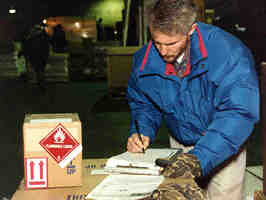 |
Jim Fox, hazardous materials
specialist, Motor Carrier Services, checks packaging against shipping
papers. Photo by David Gonzalez
|
Staff from several Mn/DOT offices are working with the Department of Public
Safety’s Division of Emergency Management, other state agencies and the federal
government to minimize terrorist threats against Minnesota.
Staff are increasing inspections of facilities such as bridges, working with
the state’s airports to improve their overall security levels and conducting
audits of hazardous materials carriers. Officials are also developing emergency
response coordination plans with other agencies in case of a major emergency.
Monitoring critical bridges, structures
Bob Vasek, operations support engineer, Maintenance, said bridge crews checked
critical bridges and tunnels throughout the state for any signs of tampering
to ensure that they remain safe. Mn/DOT is working with the State Patrol, he
said, to increase monitoring activity near critical bridges and other structures.
Included in that is use of the Metro Division Traffic Management System cameras.
Bridge inspectors and State Patrol officers, he added, are on the alert for
tampering or other suspicious activity.
"We are working with the American Association of State and Highway Transportation
Officials, the Federal Highway Administration, the Federal Emergency Management
Agency, the FBI and the Division of Emergency Management to assess threats and
system vulnerability and determine recommended actions that fit different threat
levels and our capability to support them," he said.
Improving security at state airports
The Office of Aeronautics is working with airports throughout the state to
help improve their security measures. Included are airports that have scheduled
service in cities such as Duluth and Brainerd and those that support corporate
aviation, such as the Flying Cloud Airport and the St. Paul Airport.
Dan McDowell, Aeronautics, said Mn/DOT will be working with airport managers
to help them comply with recent legislation signed by President Bush strengthening
airport security.
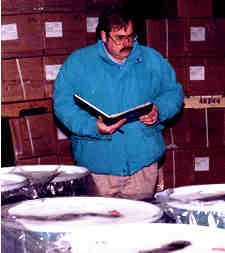 |
|
Hazardous materials
specialist Michael Ritchie, Motor Carrier Services, takes inventory of
placarded materials. Photo by David Gonzalez
|
Conducting audits of hazardous materials carriers
The Office of Motor Carrier Services, working in partnership with the U.S.
DOT’s Federal Motor Carrier Safety Administration and the Minnesota State Patrol,
is participating in a nationwide safety initiative called the HM Security Sensitivity
Visits.
Mn/DOT’s role involves transportation program specialists from OMCS performing
‘security sensitivity visits’ to 400 of 700-plus hazardous materials carriers
in Minnesota.
Priority is given to carriers of bulk explosives, anhydrous ammonia, petroleum
products, poisonous gases, etc. Investigators review the companies’ security
measures and driver roster to determine any suspicious activity, including new
drivers from countries with known terrorist activities.
The purpose of the safety and security visits is heightened awareness for suspicious
behaviors of drivers, shippers, consignees or the public. At a minimum companies
are being urged to:
-
Establish a comprehensive hiring process with detailed background checks;
-
Verify employee application information;
-
Promote security and safety training;
-
Require drivers to properly secure vehicles when stopped;
-
Avoid large population areas, to the extent possible, when transporting
hazardous materials;
-
Communicate with and solicit feedback from all level of employees;
-
Control access to areas containing hazardous materials and dangerous chemicals;
-
Conduct random and periodic security spot-checks on facilities, personnel
and vehicles;
-
Ensure drivers are aware of surroundings and secure cargo; and
-
Report suspicious activities immediately to law enforcement agencies.
The target date for completion of the safety visits is Dec. 31, 2001.
By Mary Meinert and Craig Wilkins
|
back

|
 |
Waterways provide important link to larger intermodal transportation system
|
 |
 |
Editor’s note: This is one in a series of articles looking back on the department’s
first 25 years—remembering the people, issues and cultural forces that have
shaped the agency and the milestones Mn/DOT has achieved.
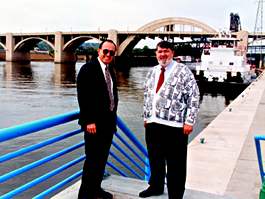 |
|
Dick Lambert, Ports
and Waterways director, and Dwayne Elliot, former planner for Ports and
Waterways, visit Lambert's Landing in downtown St. Paul, named for Lambert's
grandfather. The towboat in the background waits for 15 barges of grain
to be loaded before departing for New Orleans.
|
As highways become more congested, there is an increased emphasis on moving
freight off highways, according to Dick Lambert, director, Ports and Waterways
Section.
However, he notes, waterway transportation cannot operate without other modes.
Waterway freight is transported by rail or truck at either end; waterway transportation
is one piece of the larger intermodal transportation system. Thirty-four lake
terminals and 45 river terminals transfer cargo between land and water in Minnesota.
Legislation empowers Mn/DOT to participate in the development of policies,
plans and programs for all modes of transportation including waterways. However,
the Waterways Section has expanded from an advocacy and planning function to
investing in the waterway infrastructure through its port development program.
Additionally, it provides a statewide transportation perspective to various
organizations connected to the state’s rivers and lakes.
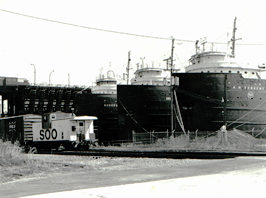 |
|
Lakers and rail cars
move iron ore at an intermodal terminal on the Duluth/ Superior port.
Rail cars bring iron ore to the ships for transport through the Great
Lakes.
|
The Minnesota Port Development Assistance Program, begun in 1991, makes state
funds available to rehabilitate Minnesota’s public port facilities. Mn/DOT administers
the program, which so far has committed $9.4 million for 15 individual projects.
Until the port development program was funded by the Legislature, the Waterways
Section served primarily as an advocate for the waterways system, according
to Tim Spencer, a former waterways planner.
Added Lambert: "The port development program was a big step for Minnesota
in realizing that you can’t keep expanding roads indefinitely to accommodate
the increased freight needs of the state. Improving the ports and building longer
locks means increased, more efficient freight transport."
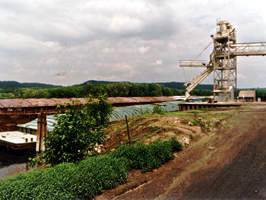 |
|
Barges are loaded with
grain at the port of Winona. Minnesota's river ports shipped more than
9.4 million tons of grain last year—two million of that was shipped from
Winona.
|
Minnesota has two waterway systems—the inland river waterways and the Great
Lakes/St. Lawrence Seaway.
Minnesota ports on Lake Superior—Duluth/Superior, Two Harbors, Taconite Harbor
and Silver Bay—ship more than 68 million tons yearly, 64 million of which is
outbound. Taconite accounts for more than 60 percent of freight shipped on lake
ports; coal is second. Other products handled include cement, steel products,
minerals, salt and packaged goods. Generally, lake traffic is open from March
25 through Jan.15.
River ports include Minneapolis, Red Wing, St. Paul, Savage and Winona. Rivers
transport primarily agricultural products—corn, soybeans and wheat. Minnesota’s
223-mile river system includes the Mississippi, St. Croix and Minnesota rivers.
River ports are usually open from the third week of March to the end of November.
By Sue Stein
|
back

|
 |
Islam discussion draws 125 employees
|
 |
 |
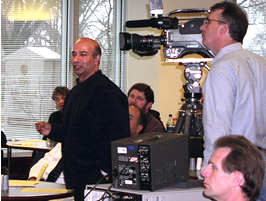 |
Iqbal Kazi,
Financial Management, contributes to the discussion at the
Nov. 14 diversity event, "The Myths and Truths about
Islam." Videotaped copies of the event are available
for checkout in the Mn/DOT library. District diversity committee
chairs also will have copies of the tapes for employee viewing.
Photo by John Tompkins
|
Approximately 125 Mn/DOT employees attended "The Myths and Truths about
Islam" program in the Transportation Building cafeteria on Nov. 14. Diversity
committees from the Program Support and Management Operations Groups, Modal
Operations Division and the Central Office Wellness Committee sponsored the
program to promote a better understanding of Islam.
Islam comes from the same tradition as Judaism and Christianity, according
to Esam M. Aal, Islamic Center of Minnesota communications director, who provided
an overview of the religion. The five pillars of Islam require practitioners
to believe in one God, pray daily at five prescribed times, give to charity,
fast in the month of Ramadan and, if possible, make a pilgrimage to Mecca. The
word "Islam" means submission and is related to the Arabic word for
peace, "Salam."
There are close to six million Muslims in America, according to the Center;
Minnesota is home to an estimated 40,000 Muslims.
Also speaking at the event was Dr. Fatma Reda, a Muslim psychiatrist and associate
professor at the University of Minnesota Medical School. Dr. Reda talked about
gender roles and about her experience in Minnesota as a Muslim woman.
Another speaker, Assistant Metro Division Traffic Engineer Amr Jabr, noted:
"Islam is a religion of tolerance, understanding and giving. If you are
confused about what Islam stands for, instead of listening to someone's interpretation
of it, buy a copy of the Koran or borrow it from the library and read some of
it; find out for yourself what it stands for."
Chief of Staff Margo LaBau introduced the session with a caution to avoid snap
judgments of people. Commissioner Elwyn Tinklenberg closed the program by thanking
the speakers for taking the time to educate the audience and answer questions
about Islam.
Videotaped copies of the event are available for checkout in the Mn/DOT library.
District diversity committee chairs will have copies of the videotapes as well.
By Sue Stein
|
back

|
 |
Ground travel expected to increase over Thanksgiving holiday
|
 |
 |
With more Minnesotans expected to travel by car and truck this Thanksgiving
holiday weekend, Mn/DOT urges drivers to check ahead for road conditions and
construction.
Motorists can get road information
on Mn/DOT’s Web site or by calling Mn/DOT’s 24-hour recorded road condition
information hotline at 651/284-0511 or 800/542-0220.
AAA national survey
A national survey from the American Automobile Association finds that Thanksgiving
travel overall is expected to decrease by 6 percent. However, 87 percent of
those who are planning trips 50 miles or more from home are expected to travel
by auto—the highest percentage recorded since AAA began keeping records in 1985.
At the same time, the survey found 4.6 million plan to fly or take a train or
bus compared to 6.3 million last year—a decrease of 27 percent.
Avoid the rush
Mn/DOT’s automated traffic recorders indicate the heaviest Thanksgiving traffic
is typically from 3 to 6 p.m. on Wednesday afternoon, with the heaviest traffic
leaving the Twin Cities on I-94 east into Wisconsin. Mn/DOT data shows this
travel is about 10 percent heavier than a typical Friday afternoon rush hour
in November. An average of 5,000 vehicles per hour is expected during the peak.
Traveling west on I-94 out of the Twin Cities, traffic is generally 6 percent
higher than typical November Friday rush hour. At peak, about 4,500 vehicles
travel this stretch per hour. Pre-Thanksgiving travel going south on I-35 is
about the same as a typical Friday rush hour in November; northbound I-35 is
about 6 percent lower than typical.
To avoid congested areas, travel before 2 p.m. or after 6 p.m. Drivers in the
Twin Cities metropolitan area can get traffic updates from KBEM radio, 88.5
FM.
Construction hotspots
To find construction zones that could affect your travel this weekend, log
onto Mn/DOT’s Web site and read the rest of the holiday
travel news release.
Click here to read other Mn/DOT
news releases.
By Pat Lund
|
back

|
 |
Time’s running out for suggesting sessions, reserving exhibit space for Transportation
Conference
|
 |
 |
The annual transportation conference—the "Great Mn/DOT Get Together"—happens
Feb. 12-13, 2002 at the Radisson South in Bloomington. Consider this an opportunity
to showcase and promote your transportation-related business, invites Sue Stein,
conference co-chair.
"We have had a few requests to extend the concurrent deadline," Stein
said. "We moved the concurrent deadline to Nov. 30, giving everyone a bit
more time." The deadline for requesting exhibit space is Dec. 14.
Visit the Transportation
Conference Web site to complete an exhibit application.
|
back

|
 |
New on the Web: Corporate Business Group
|
 |
 |
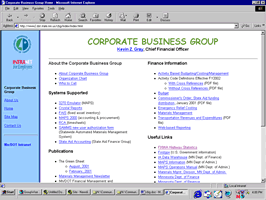 |
The new Corporate Business
Group Web site provides easy access to tools for managing Mn/DOT's fiscal
resources
|
There is something for everyone on the new Corporate Business Group Web site—whether
you’re an employee looking for tips on the RCA timesheet program or an information
technology professional installing management accounting and procurement software
or a manager needing a list of sub-object codes in order to prepare an office
budget.
"The new intranet site provides easy access to CBG products—the systems
and controls necessary to manage Mn/DOT's fiscal resources," notes Pam
Newsome, management analyst with the office.
Highlights of the site include:
-
Current and archived issues of the "Green Sheet"—a quarterly
internal report to Mn/DOT management about significant financial occurrences
and trends
-
Activity based budgeting, costing and management updates
-
Mn/DOT supplements to the MAPS operation manual
Check out the site at: http://www2.dot.state.mn.us/cbg/index/index.html
By Kay Korsgaard
|
back

|
|
 |
|



